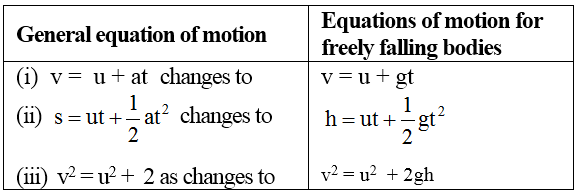Equations Of Motion For Freely Falling Object
Since the freely falling bodies fall with uniformly accelerated motion, the three equations of motion derived earlier for bodies under uniform acceleration can be applied to the motion of freely falling bodies. For freely falling bodies, the acceleration due to gravity is ‘g’, so we replace the acceleration ‘a’ of the equations by ‘g’ and since the vertical distance of the freely falling bodies is known as height ‘h’, we replace the distance ‘s’ in our equations by the height ‘h’. This gives us the following modified equations for the motion of freely falling bodies.

We shall use these modified equations to solve numerical problems. Before we do that, we should remember the following important points for the motion of freely falling bodies.
- When a body is dropped freely from a height, its initial velocity ‘u’ becomes zero
- When a body is thrown vertically upwards, its final velocity ‘v’ becomes zero
- The time taken by body to rise to the highest point is equal to the time it takes to fall from the same height.
- The distance travelled by a freely falling body is directly proportional to the square of time of fall.
